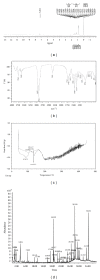Poly β-hydroxybutyrate production by Bacillus subtilis NG220 using sugar industry waste water
- PMID: 24027767
- PMCID: PMC3763576
- DOI: 10.1155/2013/952641
Poly β-hydroxybutyrate production by Bacillus subtilis NG220 using sugar industry waste water
Abstract
The production of poly β-hydroxybutyrate (PHB) by Bacillus subtilis NG220 was observed utilizing the sugar industry waste water supplemented with various carbon and nitrogen sources. At a growth rate of 0.14 g h(-1) L(-1), using sugar industry waste water was supplemented with maltose (1% w/v) and ammonium sulphate (1% w/v); the isolate produced 5.297 g/L of poly β-hydroxybutyrate accumulating 51.8% (w/w) of biomass. The chemical nature of the polymer was confirmed with nuclear magnetic resonance, Fourier transform infrared, and GC-MS spectroscopy whereas thermal properties were monitored with differential scanning calorimetry. In biodegradability study, when PHB film of the polymer (made by traditional solvent casting technique) was subjected to degradation in various natural habitats like soil, compost, and industrial sludge, it was completely degraded after 30 days in the compost having 25% (w/w) moisture. So, the present study gives insight into dual benefits of conversion of a waste material into value added product, PHB, and waste management.
Figures




References
-
- Howells ER. Opportunities in biotechnology for the chemical industry. Chemistry & Industry. 1982;8:508–511.
-
- Wood C. Environment Impact Asseesment: A Comparative Review. Harlow, UK: Longman; 1995.
-
- Banziger S, Tobler PDN, Brandl H H. The Formation of Reserve Polymers in Bacillus megaterium. Zurich, Switzerland: Microbial Ecology Course, University of Zurich; 2001.
Publication types
MeSH terms
Substances
LinkOut - more resources
Full Text Sources
Other Literature Sources
Miscellaneous

